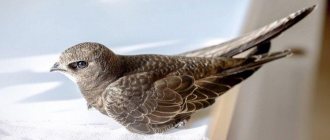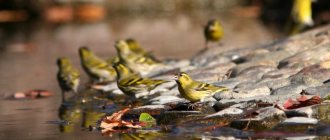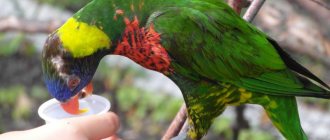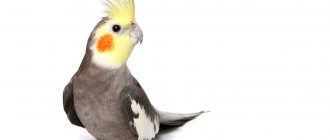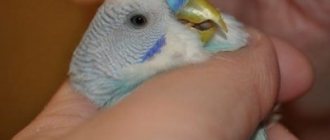In winter, especially after snow falls, the bright spots of bird plumage become especially visible against a white background.
The most frequent guests of city blocks at this time are tits - small passerine birds, whose distinctive feature is lemon-yellow plumage on the chest and abdomen. Slightly less common are bullfinches, which can be easily recognized by the bright crimson color of their breasts. Both birds constantly catch our eye in winter, but with the onset of warm weather they disappear somewhere. Where do bullfinches and tits live in the summer? Perhaps they fly away to colder regions?
Appearance and description
It is customary to call tits only those birds that belong to the tit family. The most common species in Russia is the great tit (Parus major).
Appearance of a tit
Appearance of a tit
Appearance of a tit
Appearance of a tit
Birds belonging to the order of song passerines, for the most part, differ from ordinary sparrows in being slightly larger in size and having an elongated tail. Their breast is lighter than the rest of the plumage, most often yellow, gray or beige. The beak is sharp and short, the head has a contrasting cap or crest, as well as prominent light cheeks.
The blue color of feathers, oddly enough, is not inherent in all tits. However, in some species, dark blue tones are present in the color of the feather cover of the back, cap, and flight and tail feathers.
Habitat - where it lives
Habitat of the tit
The most common species, the great tit, lives in vast areas of Eurasia and the very north of Africa. Other species of the family can be found across three continents: Eurasia, Africa and North America, as well as in the territories of the Japanese and Malay archipelagos.
Interesting fact : Birds of the tit family are not found in South America and Australia.
Tits mainly prefer to settle in deciduous forests, choosing to build nests on the outskirts of open places such as clearings and forest edges. In addition, they are not afraid to live next door to people and feel great in personal plots, gardens, city squares and forested areas.
Folk signs
The Russian sign “a tit is knocking on the window” is interpreted differently by people. Most often, a sign is considered good, foreshadowing:
- money to the house;
- good news;
- long-awaited guests;
- success in work, children's studies;
- good changes (wedding, birth of a healthy child).
It is considered a particularly good and close omen if the bird chirps provocatively.
Unpleasant interpretations of omens include news of the imminent death of loved ones, or the serious illness of the elderly. Modern city dwellers rarely encounter birds knocking on their windows; villagers prefer to believe in good omens.
Character and lifestyle
Birds of the tit family are distinguished by their incredible mobility and activity. However, despite the fact that it is difficult for birds in constant flight to hide in one place, they are absolutely unpretentious in terms of choosing their habitat. In addition, tits are very dexterous birds and, due to their tenacious and strong legs, are capable of performing real gymnastic tricks, including various somersaults.
It is thanks to the strength and development of their paws that they can survive in adverse weather, even without being able to hide in the nest. In such situations, the birds cling to a branch with their claws, shrink into a small fluffy ball and quickly fall asleep. This ability makes life much easier during periods of severe frost.
Most representatives of the tit family lead a sedentary lifestyle. However, there are also some species of these birds that can migrate from time to time. There are also exceptions to the typical pair existence. For example, gray tits sometimes form small groups or join mixed flocks with other birds to more efficiently forage during times of famine.
Interesting: Seabirds - list, names, description, photos and videos
Bullfinch - a bright bird
In winter, bullfinches sitting on branches look like ripe apples, miraculously not picked off by the autumn winds. The bright crimson plumage on the chest can be seen from afar; thanks to its characteristic coloring, this bird is difficult to confuse with other passerine species. You should know that only males have expressive breast colors, and for females nature has assigned a simple brownish “dress.”
Russian bullfinches prefer to live where coniferous forests grow, because the main dish of their winter diet is seeds, which they peck from cones with their strong beaks. However, they do not neglect other types of seeds - maple, alder, ash, etc. Bright birds love to peck elderberry or rowan berries, and they eat mainly the seeds and drop the pulp on the ground.
If bullfinches have gotten into the habit of flying into your yard, you can easily determine this by the characteristic remains of berries under the mountain ash or elderberry. In summer, they also readily feed on the seeds of wild herbs - quinoa, horse sorrel, burdock, etc.
What does it eat?
Tits love lard
Tits of all types are insectivorous birds, and they can be called real orderlies of nature. These birds, destroying countless harmful insects and their larvae, save entire forests and cultural plantings from destruction. Thus, a pair of tits feeding their offspring can completely rid more than forty trees of pests.
Interesting fact : it was previously believed that tits were exclusively insectivorous birds. However, recently, ornithological researchers have provided evidence that some species sometimes prey on small bats.
which of these birds is not migratory: nightingale, stork, tit, heron
It is only known that during flight, birds find many landmarks with the help of highly developed organs of hearing and vision, which are several times superior to human senses. Scientists do not even rule out that migrating birds are able to navigate by the location of the Sun, Moon and stars.
• Sandpiper - Tahitian curlew, nesting in Alaska, travels 9,000 km for the winter to small islands located in the central part of the Pacific Ocean. Neither winds, nor storms, nor the huge distance of flying over water, where there is not a single landmark, hinder him. During the Second World War, many pilots serving at airfields located on these islands could not even find their way back with the help of navigation instruments, and their planes, having used up their fuel supply, fell into the ocean. And waders have been coping with this task for tens of thousands of years.
How long does a tit live?
Under natural conditions, tits live on average about three years. However, in captivity, subject to the right conditions, maintenance and feeding, birds can live up to 15 years.
This difference in life expectancy is a consequence not only of the fact that animals receive the necessary care and attention every day at home, but also of their sociability and curiosity. Tits quickly get used to human society, do not experience stress in his presence and willingly make contact.
What migratory birds?
Lark, ducks, rook, cranes, cuckoo, swallows, swan, starling, nightingale, heron. Migratory birds
-
birds
that fly away to warmer regions in winter.
Migratory birds
make regular seasonal movements between nesting sites and wintering sites. Relocations can take place both close and long distances.
Interesting materials:
What does dpi mean on a mouse? What does drip mean? What does different mean in iPhone storage? What does other mean in the memory of a Samsung phone? What does dsc mean? What does dtv mean? What does duplicate name mean? What does clergy mean? What does spiritual mean? What does spirituality mean?
Reproduction of tits
Tit with chicks
Puberty in tits occurs at the age of 9-10 months. They are monogamous birds, nest in pairs, feed their offspring and defend themselves.
The breeding season for tits occurs in early to mid-spring. However, these birds begin to form pairs in the middle of winter. At this time, you can increasingly hear them chirping, see conflicts between males and courtship with females. Males, showing signs of attention, try to feed the female, showing that they can provide food for both them and the chicks. Tits also demonstrate to each other their abilities in arranging a nest, deftly manipulating twigs. At the end of winter they unite in pairs.
Interesting fact : tits that have already had experience in breeding chicks try to find their old partner, even if they have spent time apart since the last breeding season.
Typically, birds of the tit family make their nests in tree hollows, but sometimes they also use forks of branches, depressions in the ground, birdhouses and various cavities of natural or artificial origin. The construction and arrangement of the nest is most often done by the female, making a frame of flexible twigs, which is lined with moss, feathers, down, wool or found artificial materials to maintain warmth.
A pair of titmice usually hatches from two to six chicks, but cases have been recorded when 14 small birds appeared in one nest. Under the supervision of their parents, the cubs develop over about a month. Even when they begin to fly out of the nest on days 15-22, they remain under the care of adults for another two weeks.
Representatives of the tit family are able to hatch chicks once or twice, and sometimes three times a year. Birds can settle in the same nest or build a new one, but the number of eggs in the clutch decreases each time.
Nutrition
The main diet of tits are insects. Due to their unpretentiousness, they do not refuse plant foods. Favorite delicacy is fir and pine cones.
There are species of tits that enjoy chiseling the bark of a tree and pulling out larvae and other insects from under it. Often, looking at such a picture, you might think that this is a woodpecker that has changed its image.
Birds love spiders, bugs, butterflies, caterpillars, and eggs. Those who live near people do not refuse cottage cheese, bread crumbs, cereals, meat pieces, lard, berries and fruits. They don't stock food. But with great pleasure they can rob their brothers.
Muscovites, puffweeds, and nuthatches are often attacked by them. In the winter season, tits stay longer in places where there is enough food. They can visit the feeder throughout the winter and never fly far from it.
Tit chick
Why is it so useful to create bird feeders in winter? This saves many tits, which in turn save green spaces. There are suggestions that in one day an adult tit eats as many insects as it weighs.
Natural enemies
Tits sometimes fight with each other.
Tits in their natural habitat have a large number of enemies. Predators such as kites, eagles, eagle owls, owls, barn owls and golden eagles do not mind feasting on the bird. Woodpeckers also like to destroy their nests.
Interesting fact : even in ancient times, people understood the benefits of tits that exterminate insects. So, back in the 14th century, Louis of Bavaria issued a law protecting birds, according to which a significant fine was imposed for killing a tit.
Squirrels also destroy tits' houses, which is why they have to rebuild them. Fleas, which settle on the body in entire colonies, cause great harm to tits.
Interesting: Monkeys - Species with photos and videos, names, features, description, food, where they live
Singing
Tit bird
In the pleasant chirping of tits, experts distinguish more than 40 different sound combinations. Males especially love to sing and chirp almost all year round, calming down a little only in winter.
Their song consists of loud “tsi-tsi-tsi-pi”, “in-chi-in-chi”, “pin-pin-chrrrrzh”, “zin-zi-ver”, “zin-zin” and in general very diverse with endless modulations and a variety of intonations.
Types of tits
Types of tits
The tit family (Paridae) currently includes more than 60 species of birds, of which from 9 to 11 (according to various sources) live in Russia. The most common in Russia are seven species of these birds.
Great tit
Great tit
The body of a great tit (great tit) can reach a length of 17 cm, weight - 21 g, and a wingspan of 26 cm. The bird's plumage is brightly colored: on the chest it is yellow, with a black longitudinal stripe in the middle, the head is decorated with a cap, on her contrasting white cheeks stand out. The plumage of the wings and tail is bluish, with clear white stripes, the undertail is dark in color.
Bolshak is found throughout Russia, in most European countries, in the northern regions of Africa and some Asian countries. Great tits prefer to make nests in trees located near forest clearings and on the banks of reservoirs.
Brown-headed Chickadee
Brown-headed chickadee
The body length of the brown-headed chickadee (puffy chickadee) reaches 15 cm, weight – 15 g, wingspan – 22 cm. The color of the bird has no pronounced color spots, it has a gray back and feathers, a black chin and a cap that extends like a wedge onto its back, white breast and cheeks that do not have a demarcation strip.
The brown-headed chickadee is common in forest areas of Eurasia, covering areas of Great Britain and France. Puffy moths most often live in dense coniferous and mixed forests, in places remote from human settlements.
Moskovka
Muscovy
The length of the Muscovy's body is 12 cm, the maximum weight is 12 g, the wingspan is 21 cm. This tit has a light gray belly, back, nape and cheeks. But due to the predominance of dark feathers on the top of the head, shirtfront under the beak and neck, the bird is often called a black tit. Some representatives of this species have a prominent crest on the top of their head.
Muscovites live in forested areas of Eurasia throughout the continent, from west to east. And in southern latitudes they are found even in some areas of Africa, India and China. They prefer to settle in pine needles, but can move to mixed forests and even to orchards.
Tufted tit
Tufted Tit
The body of the Tufted Tit (Grenadier) reaches 14 cm, weight - 14 g, wingspan - 22 cm. This bird received its name because of the sharp striped crest on its head. The tit's back is grayish-brown, and its belly is gray-beige. There is a distinctive black necklace on the neck, a stripe also outlines the cheeks and marks the area between the beak and the chest.
The grenadier is common in most European countries, throughout the European part of Russia and in the south of the Urals. Tufted tits usually choose coniferous forests as habitats, but in some cases they can settle in mixed forests.
Blue Tit
The common
blue tit has a body length of no more than 12 cm, a maximum weight of 14.7 g, its wingspan can reach 20 cm. The bird is distinguished by the blue color of the feathers on the wings and tail, which are bordered by black and white stripes. The white head of the blue tit is covered with a blue cap, the neck is outlined with a dark blue line. Also, a vertical stripe runs through the tit's yellow-green abdomen.
The habitat of the common blue tit is the subtropical, temperate and subarctic zones of Europe, Asia and Africa. These tits prefer to nest in mixed forests with a predominance of birch and oak trees.
Swamp chickadee
Swamp chickadee
The body length of the swamp chickadee can reach 14 cm, weight – 15 g, and the width of the wingspan – 20 cm. The bird is also called black-headed for the dark cap “dressed” on its head. The belly and back are gray-beige, the collar and cheeks are lighter in color, and there is a black spot under the beak. The feathers of the wings and tail are brown.
Interesting: Crow
